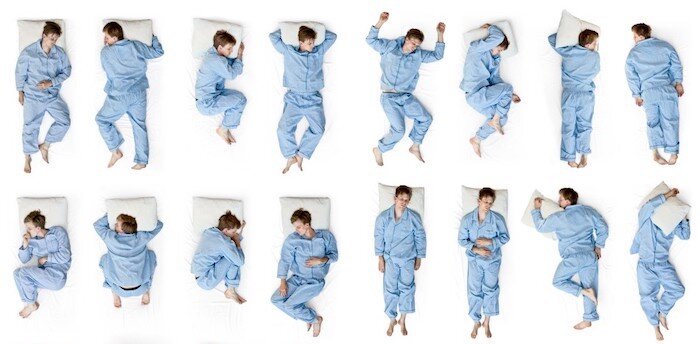
When you sleep, you lose conscious control over your body, and you can end up twisting your spine or tucking your pelvis in. Existing back pain can get further aggravated, resulting in a restless night of sleep. Using supported sleeping postures can prevent the concentration of stresses on your spine, keep your back relaxed, and create a healing environment.
As a general rule, avoid sleeping on your stomach it disturbs the normal alignment of your spine. Also avoid sleeping on the side that hurts more, especially if you have sciatica, and follow these guidelines:
Back Sleepers: Elevate Your Knees
If you prefer sleeping on your back, place a pillow beneath your knees. By slightly raising your knees, you will reduce stresses on your lower back and maintain the natural curve of your spine.
Use a head pillow for head and neck support and to maintain spinal alignment.
Side Sleepers: Keep Your Hips Stacked
If you’re a side sleeper, place a firm, flat pillow between your knees. The pillow will align your lower spine with your hips and prevent the leg on top from creating pressure on your lower back and/or pelvis. This position also helps relieve stresses in your lower spine, creating room for your spinal nerves.
Use a head pillow to slightly raise your head so that your shoulders are in alignment.
Align Your Ribs and Pelvis
While sleeping on the side you may also consider using a lumbar support cushion or waist pillow under your waist. This pillow will help maintain alignment between your ribs and pelvis for upper and lower back support.
Avoid Excessive Curling in The Fetal Position
Curling up while sleeping on your side (fetal position) may provide a nestled feeling, but make sure to not curl too tight, which can restrict your breathing and leave you with a sore back especially if you have spinal osteoarthritis.
Select a medium-firm mattress
To get a comfortable night of sleep, your mattress needs to be adequately supported. A mattress with ergonomic standards and the right level of firmness may help promote better sleep, typically by providing an even surface and reducing body aches and pains.
Excessively firm or soft mattresses can cause back pain and aches in other areas of the body. For example:
- A firm mattress can disturb your neck and back support and lead to the concentration of stresses on your shoulder joint, causing pain and stiffness.
- A soft mattress may cause your pelvic area to sag in due to your body weight, causing your upper body to be pulled out of alignment.
A medium-firm mattress is generally accepted as a well-supportive option.
Restorative sleep is imperative when trying to reduce your back pain. Follow these postural tips while you sleep to help keep your spine and its surrounding tissues in alignment and in a relaxed state, to help you get more restful, deep sleep.
Precision Pain Care and Rehabilitation has two convenient locations in Richmond Hill – Queens and New Hyde Park – Long Island. Call the Richmond Hill office at (718) 215-1888, or (516) 419-4480 for the Long Island office, to arrange an appointment with our Interventional Pain Management Specialist, Dr. Jeffrey Chacko.













